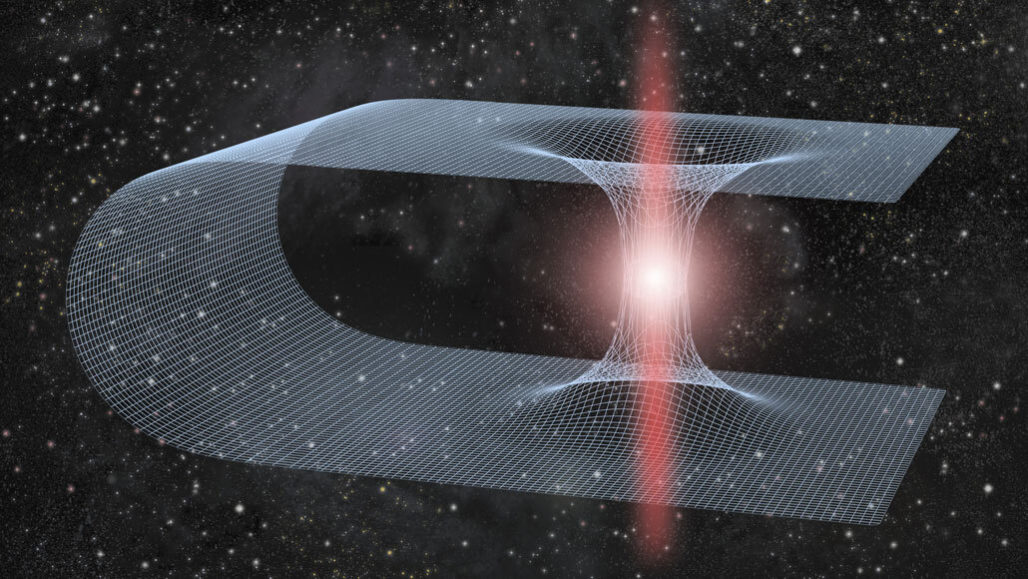Astronomers think they might be able to detect black holes falling into wormholes using ripples in spacetime known as gravitational waves, but only if wormholes really exist and such a situation ever happened, a new study discovers.
According to Einstein, who first predicted the existence of gravitational waves in 1916, gravity results from the way in which mass warps space and time. When two or more objects travel within a gravitational field, they produce gravitational waves that travel at the speed of light, stretching and squeezing space-time along the way.
Gravitational waves are insanely difficult to detect because they are immensely weak, and even Einstein was uncertain whether they really existed and if they would get discovered. After decades of work, scientists reported the first direct evidence of gravitational waves in 2016, observed using the Laser Interferometer Gravitational-Wave Observatory (LIGO).
Black Holes vs. Wormholes
Gravitational-wave observatories have found more than 20 giant collisions between highly dense and massive objects like black holes and neutron stars. However, a wider variety of exotic objects could exist, scientists have theorized wormholes could be one of them, the collisions of which should also create gravitational signals that can be detected by scientists.
Wormholes are tunnels in spacetime that theoretically can allow travel anywhere in space and time, or even to dimensions beyond this like other dimensions. Einstein’s theory of general relativity allows for the possibility of wormholes, although whether they really exist is still up for debate. Some of the scientific community are yet to be convinced.
In principle, all wormholes are unstable, closing the instant they open. The only way to keep them open and traversable is with a unique form of matter called “negative mass”. Such unique matter has equally unique properties, including flying away from a standard gravitational field instead of falling toward it like normal matter. No one knows if such unique matter actually exists.
In several ways, a wormhole share the characteristics of a black hole. Both types of objects are extremely dense and have powerful gravitational pulls for objects their size. The differentiating factor is that no object can get back out after approaching a black hole’s event horizon – theoretically anyway – the threshold where the speed needed to escape the black hole’s gravitational pull exceeds the speed of light – whereas any object entertains a wormhole could theoretically reverse course.
Assuming wormholes might actually exist, experts have investigated the gravitational signals created when a black hole orbits a wormhole for a new paper, which has not yet been peer-reviewed. The researchers also explored what might happen when the black hole enters one mouth of the wormhole, exists out the wormhole’s other opening into another location within space-time, and then – assuming the black hole and wormhole are gravitationally linked to each other – falls back into the wormhole and emerges out the other side.
No Getting Out
In computational models, the researchers assessed the interactions between a black hole five times the mass of the sun and a stable traversable wormhole 200 times the mass of the sun with a tunnel 60 times wider than the black hole. The models suggested that gravitational signals unlike any seen up to now could occur when the black hole journeyed into and out of the wormhole.
When two black holes spiral closer to one another, their orbit’s speed increases, much like spinning figure skaters who draw their arms closer to their bodies. In turn, the frequency of the gravitational waves goes up. The sound these gravitational waves could create is a chirp, much like when one grows the pitch quickly on a slide whistle since any increase in frequency correlates to growing pitch.
Black holes and wormholes are one of the deep mysteries of the universe, and we are not even sure they exist yet. If they do in fact exist and we better understand how they influence space-time we could possibly get to the point where we could use wormholes as they have in so many science fiction movies. But with what we currently know, that is a distant fantasy. Scientists will tirelessly continue researching the skies.
